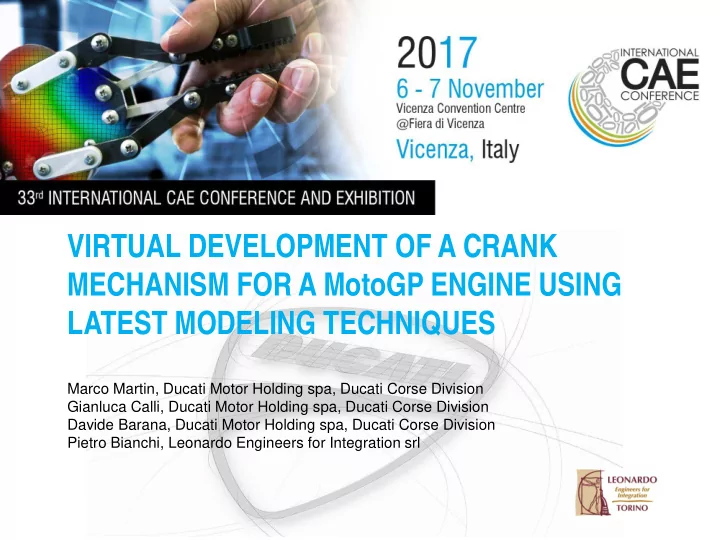

VIRTUAL DEVELOPMENT OF A CRANK MECHANISM FOR A MotoGP ENGINE USING LATEST MODELING TECHNIQUES Marco Martin, Ducati Motor Holding spa, Ducati Corse Division Gianluca Calli, Ducati Motor Holding spa, Ducati Corse Division Davide Barana, Ducati Motor Holding spa, Ducati Corse Division Pietro Bianchi, Leonardo Engineers for Integration srl
www.caeconference.com agenda Introduction D16GP engine Preliminary calculations Model set- up Model validation Results Future developments Conclusions 33 rd INTERNATIONAL CAE CONFERENCE AND EXHIBITION 2017, 6 - 7 November 2
www.caeconference.com Introduction How to produce a new version of crankshaft that is: powerful, safety, in a short time and with reduced experimental tests available? Cranktrain dynamic model 33 rd INTERNATIONAL CAE CONFERENCE AND EXHIBITION 2017, 6 - 7 November 3
www.caeconference.com D16GP engine 4 stroke spark ignition, 1000 cm 3 4 cylinders, “V” lay- out 90° cylinder bank angle Desmodromic distribution Note: the engine has been simulated as it were installed in the test bench. 33 rd INTERNATIONAL CAE CONFERENCE AND EXHIBITION 2017, 6 - 7 November 4
www.caeconference.com Preliminary calculations Simplified FEM model to investigate different crankshaft geometries with MSC Marc. Two geometries selected and tested with Engdyn\Valdyn (different main and pin journals radii and thicknesses). 33 rd INTERNATIONAL CAE CONFERENCE AND EXHIBITION 2017, 6 - 7 November 5
www.caeconference.com Model set- up Motorcycle engine lay- out! Engdyn\ Valdyn co-simulation. Very high engine speed vibrations predominant (both from cranktrain & engine block). 33 rd INTERNATIONAL CAE CONFERENCE AND EXHIBITION 2017, 6 - 7 November 6
www.caeconference.com Model set- up: Engdyn Crankshaft: dynamic. Mass and stiffness properties derived from a mesh discretization. The assembly includes: crankshaft, pinion and flywheel. Cylinder block: component mode synthesis of the first 50 th modes. The assembly includes: carters, heads, covers and the test bench frame. Meshes obtained with Ansys 17.2. 33 rd INTERNATIONAL CAE CONFERENCE AND EXHIBITION 2017, 6 - 7 November 7
www.caeconference.com Model set- up: Engdyn Mechanical links defined to receive forces and moments from Valdyn and send displacements to Valdyn. Interfaces involved with the co- simulation: timing bearings, drive line bearings, pinion gear. The cylinder block simulated in Engdyn sees all the main loads, thermal ones excluded for the moment, though they can be added during the modal reduction (planned). Oil properties derived from internal data base. Cylinder pressure derived from CFD Ducati Corse models. 33 rd INTERNATIONAL CAE CONFERENCE AND EXHIBITION 2017, 6 - 7 November 8
www.caeconference.com Model set- up: Valdyn The pinion\primary gearing influences the crankshaft’s behavior. A detailed representation of drive line and timing has been set- up. A PID controller has been adopted to avoid wind- up problems deriving from lash and low stiffness components (especially brake’s elastomeric joint). 33 rd INTERNATIONAL CAE CONFERENCE AND EXHIBITION 2017, 6 - 7 November 9
www.caeconference.com Model validation Checks through kinetostatic model and FEM modal analysis. Deeper validation of the model through a numerical comparison with another virtual engine model historically used in Ducati Corse built with Valdyn. Direct comparison numerical\ experimental planned. 33 rd INTERNATIONAL CAE CONFERENCE AND EXHIBITION 2017, 6 - 7 November 10
www.caeconference.com Results Time of calculation to do a complete sweep of engine speeds with co- simulation: 18 hours. Safety factors in the main and pin journals fillets of the crankshaft. 33 rd INTERNATIONAL CAE CONFERENCE AND EXHIBITION 2017, 6 - 7 November 11
www.caeconference.com Results Huge amount of data extracted with the model, included hardly measurable outputs. Torsional and bending moments extracted to generate the boundary conditions of some other FEM analysis (for ex. Flywheel durability). Bearings’ power loss and oil flow rate: comparison with Ducati Corse’s CFD calculation and considerations about frictions’ reduction. 33 rd INTERNATIONAL CAE CONFERENCE AND EXHIBITION 2017, 6 - 7 November 12
www.caeconference.com Future developments Direct experimental measures to * complete the model validation. More detailed description of the connecting rod & piston. Detailed calculations focused on the bearings elastohydrodynamic bearing model. * FEM analysis of the cylinder block using all the dynamic loads calculated by the model + thermal loads cylinder block safety factors. * Courtesy of Ricardo Software 33 rd INTERNATIONAL CAE CONFERENCE AND EXHIBITION 2017, 6 - 7 November 13
www.caeconference.com Conclusions Understanding Little time complex engine available from dynamic CAD to track behaviors Cranktrain dynamic model Performances (Reduction of Safety friction & lightweight) 33 rd INTERNATIONAL CAE CONFERENCE AND EXHIBITION 2017, 6 - 7 November 14
www.caeconference.com The authors Marco Martin marco.martin@ducati.com Gianluca Calli gianluca.calli@ducati.com Davide Barana davide.barana@ducati.com Pietro Bianchi pietro.bianchi@leonardointegration.com www.ducati.com www.leonardointegration.com 33 rd INTERNATIONAL CAE CONFERENCE AND EXHIBITION 2017, 6 - 7 November 15
Recommend
More recommend